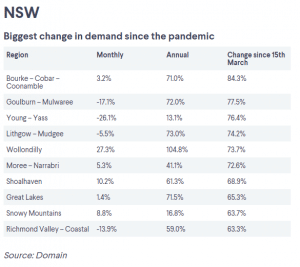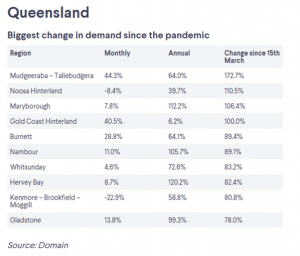Country or City – Where do people want to live after Coronavirus?
Australians have long sought after the “Tree Change” or “Sea Change” phenomenon where they take a lifestyle decision to move to either the country for the cleaner air, or the beach for the water and lifestyle that provides.
Well it seems that the Coronavirus pandemic has more and more people considering their options about both their living arrangements, ability to work from home as well as the lifestyle they choose to live.
No longer is there a buzz to live in high rise apartments in and amongst the city lights as this close quarter living has proven to be an issue with the spread of the virus.

We recently wrote about the Coronavirus pandemic had changed what people want from the residences and it seems now that a potential shift in our lifestyles is also high on the agenda.
Those “likely to buy” are classified by the actions they take on Domain, like shortlisting a home, sending an inquiry, completing a property inspection and frequently viewing photos and the property listing.
A higher positive percentage change indicates the buying and selling environment favours sellers, the opposite buyers.
It found that both houses and apartments in the outer suburban areas of Sydney, Melbourne, Brisbane and Perth were in the highest demand in those cities for the month up to September 6.
“The current health crisis has changed the way we use our homes, and for some, altered our purchasing decisions and property wish lists,” said Domain senior research analyst Nicola Powell.
Demand from serious buyers, or those more “likely to buy”, has increased in most capital cities around Australia as pent-up demand from the coronavirus-related lockdown dissipates through property markets.
The indicator showed that since the pandemic began, demand has increased everywhere but Melbourne and Hobart, with serious buyers showing the biggest increase in activity in Darwin.
Melbourne’s low demand for property, falling 24.8 per cent since the start of the pandemic, was due in part to the lack of physical inspections as part of the stage four lockdown, Dr Powell said.
However, regional Victoria outperformed the city by 45.8 per cent.
Now I was raised in country Victoria and spent the best part of my childhood and early adult life in Country Victoria so I feel like I’m pretty well versed to discuss the benefits of country living. The air is clean, there is less traffic and life overall, seems a lot simpler.
I spent a long time in the Wimmera region and central Victoria and there are some great tourist destinations that explains our history, particularly through the gold rush. These areas have access to regional cities and of course Melbourne is accessible as our road networks continue to improve.
Melbourne’s low rate of demand, falling 24.8 per cent for houses and same for units, was due to the second lockdown, which had discouraged serious buyers from looking for property, Dr Powell said.
“You would expect it to fall because people can’t do these high intent actions,” she said. “People can still complete inspections if they can do them virtually but they aren’t always willing to do that.
“As Melbourne relaxes restrictions, the indicator will bounce as we release some of that pent-up demand. Then after that it should go back to a normal tracking.”
Regional Victoria outperformed the city, with 21 per cent growth in serious buyers following the beginning of the pandemic for houses and 26.7 per cent for units.
The Maryborough and Pyrenees region had the most growth in demand at 68 per cent, Heathcote, Castlemaine and Kyneton were next at 55 per cent and the Upper Goulburn Valley in third with 52.9 per cent.
The best performer in the greater Melbourne region was Manningham East, which recorded a 37 per cent increase.
Manningham takes in areas like Dandenong, which Dr Powell said reflected the growing trend for buyers to favour further locations now that working from home was more common.

Sydney’s property market recovered well following the lifting of coronavirus-related restrictions, with demand from serious buyers up 14.1 per cent for houses since the pandemic began. Units were more subdued at 4.5 per cent.
Regional NSW outperformed in both houses and units, up 30.5 per cent and 25.9 per cent respectively.
Because of this, Sydney suburbs appear low on the list of regions with the most demand.
Topping the most in-demand regions is Bourke, Cobar and Coonamble, with interest increasing by a whopping 84.3 per cent.
Dr Powell said the most activity in Sydney was in locales less connected to the city centre.
“In Sydney those areas in the top 10 have been segregated into two areas,” she said. “There’s a lot of leafy areas with bigger block sizes and better affordability.
“If working from home is the new norm, the location is less crucial.
“Then there’s McGrath Hill and others which are prime development areas, which may be reflecting first-home buyer demand.”
Sydney has the harbour and then its amazing beaches along with being our most populated capital city. But it’s also this population in close inner city living that Sydneysiders are very accustomed to, but post pandemic, again, it’s this close living that has most people concerned.
And most major employers are encouraging their staff to actually stay at home and work remotely, so now, one of the single biggest reasons why people live in the cities all around our country – for work – is flexible enough to do this from home, then it appears that people are considering the open spaces and lifestyle that comes with this.

Demand for Brisbane houses grew 18 per cent since the crisis began. Units didn’t do as well, but were still up 5.6 per cent.
Regional Queensland was again better on both measures, up 27.9 per cent and 16 per cent for houses and units respectively.
Dr Powell said lifestyle areas like the Sunshine and Gold coasts were performing well, and closer to Brisbane the Moreton Bay region on the city’s northern fringe had good growth in interest too.
“Those are the areas which are affordable and attractive to first-home buyers,” she said. “When you have government incentives as well, perhaps it’s helping drive demand towards these areas where you can get a block of land.”
Whether you like the Queensland Premiers way of protecting her fellow Queenslanders or not, her popularity is improving going into a State election.
And let’s be honest, Brisbane is a nice city but it’s not exactly got the great beaches such as the Sunshine Coast, Gold Coast or beyond.
All in all, people are weighing up their future living options a lot more and this will have an impact on all housing markets as we normalise into the future and learn to live with the Virus.
Watch this space, our markets could be in for a change based on lifestyle rather than needs, mainly around their work.

